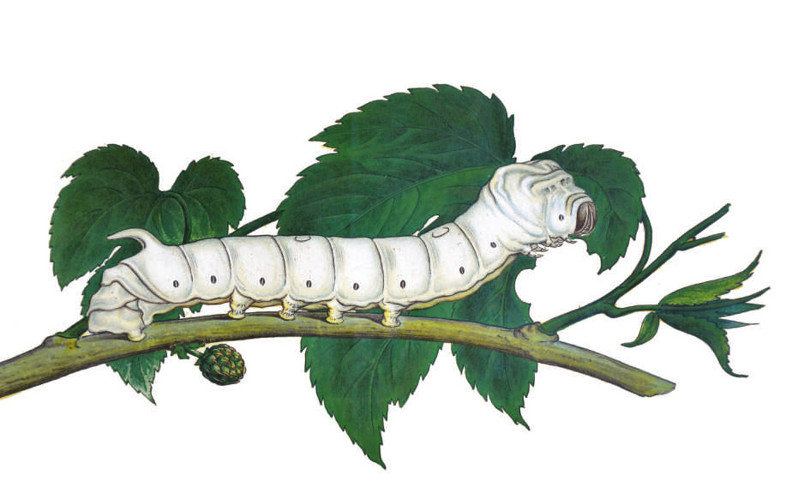Display board 5
THE SILKWORM
Silk is produced by the larva of the Bombyx mori moth originating in east central Asia. In its larval stage this lepidopteran feeds exclusively on mulberry leaves, and no longer exists in a wild state. Its life cycle is completed in approximately 45 days.
When just born the larva is dark, about 3 millimetres long and weighs about half a milligram. At its greatest size, the larva reaches 9 cm and weighs 4 grams. Therefore, over the period of a month, the larva has grown by 30 times its length and 9,000 times its weight. This extraordinary development is not continuous but takes place in stages separated by moults also known as sleeps. After four moults, the torpor of the larva stage alters into a period of agitation and movement known as "fury", and the larva tries to climb to find a support on which to attach its cocoon. To enable the silkworm to do this the farmers carefully position the dry branches, to make the mountages known as "bosco".
The silk is produced by the larva through two glands beneath its mouth. The saliva they secrete consists of two very fine filaments of a protein substance called fibroin, not soluble in water. The two filaments/strands are coated with a sticky sheath of a protein called sericin. The cocoon is made from a single, highly resistant thread which can be as long as 1,800 metres.
In three or four days the larva has completely wrapped itself in silk and turns into a chrysalis. Finally, after a period of about 15 days, the last mutation takes place and the moth emerges from the cocoon. The adult insect does not feed and its only duty is to ensure the conservation of the species. Each female, once fertilized, can deposit between 400 and 500 eggs.
Specialized Bacological Institutes controlled the cross-breeding to produce the eggs which were stored in cool places and sold the following year to the various buyers.
WOMEN AND "CAVALIERS"
The most favourable period in the year for sericulture was the late spring when farming activities were practically at a standstill. Silkworms were raised in almost all the rural buildings to boost the incomes of the peasant families, particularly in the period before the harvest.
Since this activity was not very tiring and at the same time needed delicate and continuous care, it mainly involved women and children.
In the big kitchens of these farmhouses, after the eggs hatched, the larvae were looked after for 45 days on purpose-built wooden frames known as "arele". These voracious little animals developed very quickly, feeding several times a day on mulberry leaves, washed, dried and shredded. Their litter had always to be kept clean.
In the period immediately preceding their climb to the mountages, the silkworms became more and more ravenous. The noise of their jaws grew to become a continuous, deep rumble which made the whole house vibrate. Collecting mulberry leaves caused a ceaseless coming and going from the trees, by now nearly bare, to the frames where the larvae grew in the blink of an eye. In May the last moult usually took place, while in June the cocoons were sold and the first income earned (the so-called "prima entrada").
The silkworms were known in local dialect as "cavaliers", almost like saying the insect, for its delicacy, should be treated like a cavalier, that is esteemed and held in great respect, because of its precious product, once so important for the local economy.
